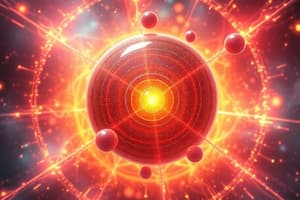Podcast
Questions and Answers
ما هي الجسيمات الفرعية التي توجد في نواة الذرة وتتحمل الشحنة الإيجابية؟
ما هي الجسيمات الفرعية التي توجد في نواة الذرة وتتحمل الشحنة الإيجابية؟
- البوزيترونات
- النيوترونات
- الإلكترونات
- البروتونات (correct)
ما هي المادة التي تشكل معظم كتلة الذرة؟
ما هي المادة التي تشكل معظم كتلة الذرة؟
- البروتونات
- النيوترونات (correct)
- الإلكترونات
- البوزيترونات
ما هو دور الإلكترونات في الذرة؟
ما هو دور الإلكترونات في الذرة؟
- تشكيل الشحنة الإيجابية للذرة
- المساهمة في استقرار الذرة (correct)
- تحديد عدد البروتونات في الذرة
- تشكيل معظم كتلة الذرة
ما هو اسم الجسيمات الفرعية التي تحمل شحنة إيجابية وتوجد في نواة الذرة؟
ما هو اسم الجسيمات الفرعية التي تحمل شحنة إيجابية وتوجد في نواة الذرة؟
ما هو الجزيء الأساسي لجميع الجزيئات الهادرونية، بما في ذلك البروتونات والنيوترونات؟
ما هو الجزيء الأساسي لجميع الجزيئات الهادرونية، بما في ذلك البروتونات والنيوترونات؟
ما الذي يُعتَقَد أنه يُحافِظ على استقرار الأنوية الذرية من خلال منع البروتونات والنيوترونات من التفكك؟
ما الذي يُعتَقَد أنه يُحافِظ على استقرار الأنوية الذرية من خلال منع البروتونات والنيوترونات من التفكك؟
ما الذي يُعَدّ بشكل أساسي عدد البروتونات في نواة الذرة؟
ما الذي يُعَدّ بشكل أساسي عدد البروتونات في نواة الذرة؟
ما هو نوع القوة المسؤولة عن تفاعل الذرة مع جسيماتها المشحونة مثل الإلكترونات والبروتونات؟
ما هو نوع القوة المسؤولة عن تفاعل الذرة مع جسيماتها المشحونة مثل الإلكترونات والبروتونات؟
ما هي الاكتشافات التي تم دمجها في النموذج القياسي؟
ما هي الاكتشافات التي تم دمجها في النموذج القياسي؟
ما هو التصنيف الذي يقدم إطارًا نظريًا لجميع جزيئات الطاقة الفرعية المعروفة وخصائصها؟
ما هو التصنيف الذي يقدم إطارًا نظريًا لجميع جزيئات الطاقة الفرعية المعروفة وخصائصها؟
ما يشير إليه النموذج القياسي؟
ما يشير إليه النموذج القياسي؟
ما الذي يحكم استقرار وخصائص الهياكل الذرية؟
ما الذي يحكم استقرار وخصائص الهياكل الذرية؟
ما يوفره النموذج القياسي إطارًا شاملاً لفهم مجموعة متنوعة من؟
ما يوفره النموذج القياسي إطارًا شاملاً لفهم مجموعة متنوعة من؟
Study Notes
The Atom: A Comprehensive Guide to Subatomic Particles
The atom is considered the basic building block of matter, and it consists of various subatomic particles. These particles interact with each other to create the complex and diverse world we inhabit. In this article, we will explore the subatomic particles that make up the atom, their properties, and the forces that govern their interactions.
Subatomic Particles
Subatomic particles are the fundamental constituents of all matter and energy. They include:
- Protons: These are positively charged particles found in the nucleus of atoms and are responsible for the positive charge of an atom.
- Neutrons: Neutrons are neutral particles also found in the nucleus of atoms, and they are responsible for the majority of an atom's mass.
- Electrons: Electrons are negatively charged particles that move around the nucleus, bonding with protons and contributing to the stability of the atom.
In addition to these particles, there are other subatomic particles such as alpha and beta particles, as well as quarks. Quarks are believed to be the fundamental building blocks of all hadronic particles, including protons and neutrons.
Atomic Structure
The atom is composed of these subatomic particles in a specific arrangement. A typical atom consists of three subatomic particles: protons, neutrons, and electrons. The nucleus, which is the small, dense area at the center of every atom, is composed of protons and neutrons. The number of protons in the nucleus, known as the "atomic number," primarily determines the characteristics of an element.
Interactions between Subatomic Particles
Subatomic particles interact with each other through various forces, which can be categorized into three main types:
- Strong Force: This force holds protons and neutrons together in the nucleus, preventing them from falling apart. It is responsible for maintaining the stability of atomic nuclei.
- Weak Force: The weak force is responsible for nuclear decay processes, such as the decay of unstable atoms into more stable ones. It also plays a role in certain subatomic interactions, such as beta decay.
- Electromagnetic Force: This force is responsible for the interactions between charged particles, such as electrons and protons. It is responsible for the stability of the atom, as electrons are attracted to the positively charged protons in the nucleus.
The Standard Model
The Standard Model is a theoretical framework that provides a classification scheme for all known subatomic particles and their properties. It incorporates the discoveries made in particle physics, such as the existence of quarks and the properties of the Higgs boson. The Standard Model has been instrumental in advancing our understanding of the nature of matter and energy, as well as the origins of the universe.
Conclusion
Subatomic particles are the fundamental units of matter and energy that make up the atom. They interact with each other through various forces, which govern the stability and properties of atomic structures. The Standard Model provides a comprehensive framework for understanding the diverse range of subatomic particles and their interactions, shedding light on the complex nature of the universe we inhabit. As our understanding of subatomic particles continues to grow, we can only expect to uncover more about the mysteries of the atomic world and the origins of the universe.
Studying That Suits You
Use AI to generate personalized quizzes and flashcards to suit your learning preferences.
Description
Explore the fundamental components of matter and energy, from protons, neutrons, and electrons to the forces that govern their interactions. Learn about the structure of the atom, the interactions between subatomic particles, and the theoretical framework of the Standard Model in this comprehensive guide.




